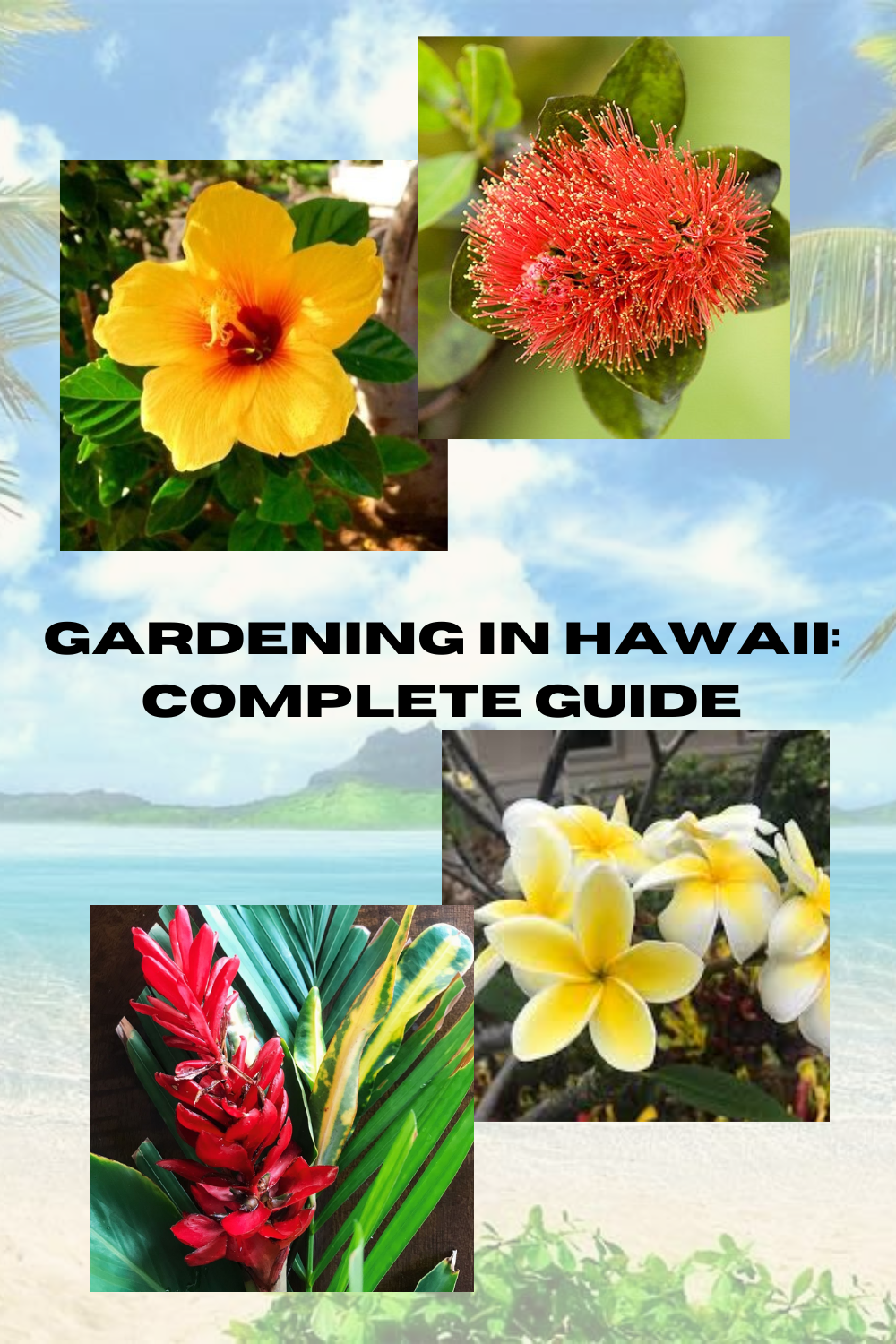Gardening in Hawaii offers unique opportunities and challenges due to its diverse microclimates, rich volcanic soil, and tropical weather. Successful gardening requires understanding local conditions, selecting appropriate plants, and managing water and pests effectively. Native and tropical plants thrive, making Hawaii a gardener’s paradise year-round.
1. Climate and Microclimates of Hawaii
Hawaii’s tropical climate is ideal for many plants due to its warm temperatures year-round. However, the islands’ varying microclimates, influenced by factors such as rainfall patterns (windward vs. leeward) and elevation, create diverse conditions that affect plant growth. Higher elevations like Kula on Maui and Waimea on the Big Island have cooler temperatures, requiring different plant selections compared to the warmer coastal regions. Understanding these variations is crucial for effective gardening, agriculture, and ecological management in Hawaii.

General Tropical Climate of Hawaii
- Temperature: Hawaii enjoys a tropical climate with warm temperatures throughout the year, generally ranging from 70°F to 85°F (21°C to 29°C).
- Ideal for Plants: This consistent warmth is conducive to the growth of a wide variety of plants, both native and introduced species.
Microclimates of Hawaii
Hawaii’s unique geography creates a diverse range of microclimates within the islands. These microclimates are influenced by factors such as rainfall, humidity, and temperature, which vary significantly even over short distances.
Rainfall and Humidity:
- Windward vs. Leeward:
- Windward Sides: These are the northeastern sides of the islands, facing the prevailing trade winds. They receive significantly more rainfall due to orographic lift, where moist air rises over the mountains and cools, resulting in precipitation.
- Leeward Sides: The southwestern sides are in the rain shadow of the mountains, receiving much less rainfall and experiencing drier conditions.

Elevation of Hawaii
Temperature Variations with Elevation:
- Higher elevations in Hawaii can be markedly cooler than the coastal regions.
- Examples:
- Kula (Maui): Located on the slopes of Haleakalā, Kula experiences cooler temperatures due to its higher elevation.
- Waimea (Big Island): Situated in the uplands of the Big Island, Waimea also enjoys a cooler climate compared to the coastal areas.
2. Soil of Hawaii
Volcanic soil, such as that found in Hawaii, has unique properties that make it both rich and challenging for plant growth. Here’s a closer look at these characteristics and practical advice on managing them for optimal plant health:
Volcanic Soil in Hawaii
Mineral Richness of Hawaii:
- Nutrient Composition: Volcanic soils are typically rich in essential minerals like potassium, magnesium, and calcium, which are beneficial for plant growth.
- Drainage: These soils often have good drainage properties, which can help prevent root diseases.
Nitrogen Deficiency of Hawaii:
- Low Nitrogen Levels: Despite the abundance of minerals, volcanic soils often lack sufficient nitrogen, which is crucial for plant growth and development.
- Remediation: To address nitrogen deficiency, you can incorporate organic matter into the soil. Adding compost, well-rotted manure, or organic fertilizers like blood meal, fish emulsion, or soybean meal can significantly improve nitrogen levels.
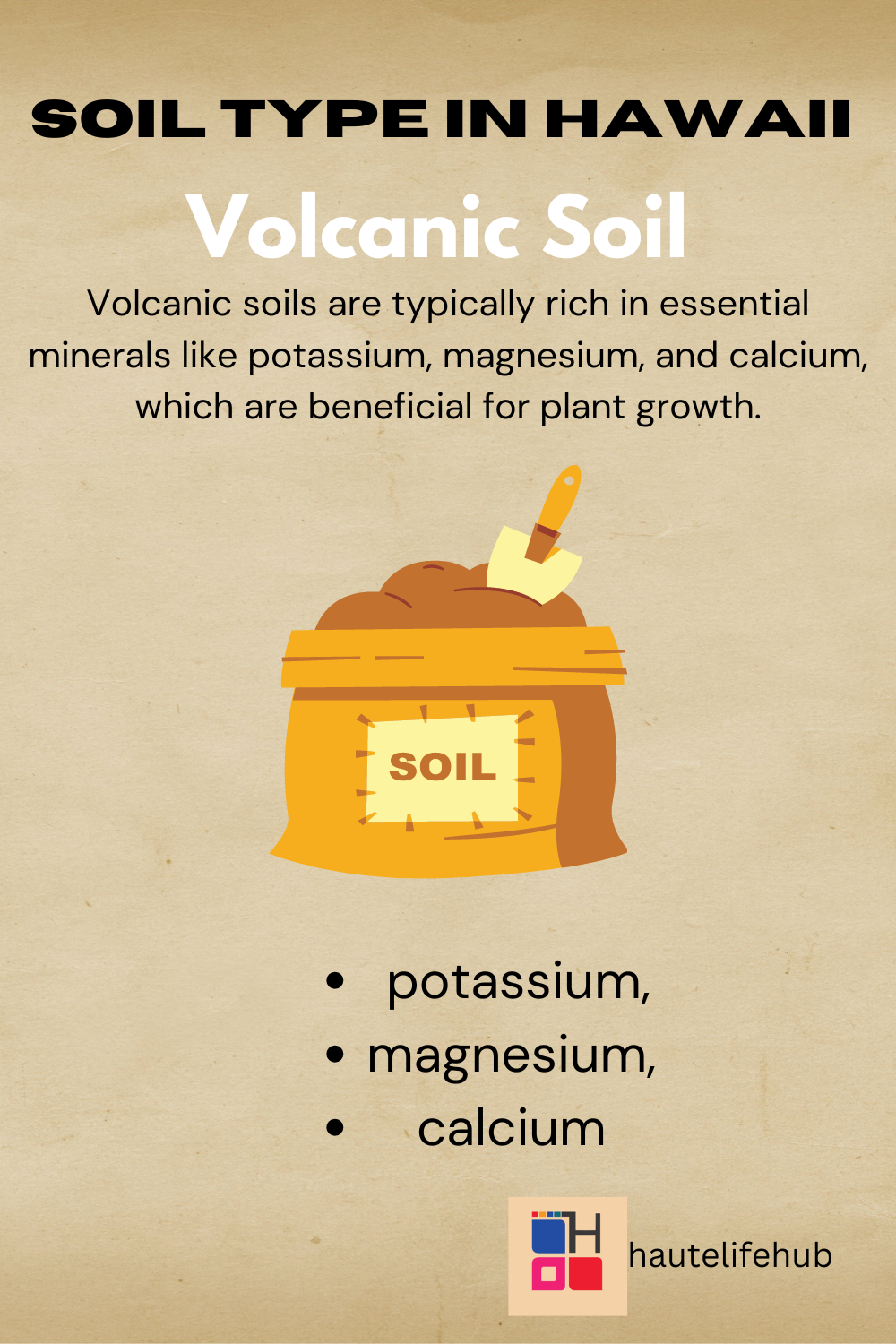
Managing Soil pH of Hawaii
Variable pH Levels:
- Testing Soil pH: Volcanic soils can have varying pH levels, which can influence nutrient availability to plants. It’s essential to test the soil pH using a reliable soil test kit or by sending samples to a soil testing laboratory.
- Adjusting pH:
- Lowering pH (Making Soil More Acidic): If the soil pH is too high (alkaline), you can lower it by adding sulfur, aluminum sulfate, or organic materials like pine needles, peat moss, or composted leaves.
- Raising pH (Making Soil More Alkaline): If the soil pH is too low (acidic), you can raise it by adding lime (calcium carbonate) or wood ash.
Practical Tips for Soil Management in Hawaii
- Regular Soil Testing: Regularly test your soil to monitor its pH and nutrient levels. This helps in making informed decisions about soil amendments.
- Compost Addition: Regularly add compost to improve soil structure, enhance microbial activity, and increase nutrient availability.
- Organic Mulches: Use organic mulches like straw, grass clippings, or wood chips to retain soil moisture, regulate soil temperature, and slowly release nutrients into the soil.
- Crop Rotation and Cover Crops: Implement crop rotation and grow cover crops (like clover or legumes) to enhance soil fertility and structure. Cover crops can also help fix nitrogen in the soil naturally.
- Water Management: Ensure proper irrigation to avoid overwatering, which can leach nutrients, especially nitrogen, from the soil.
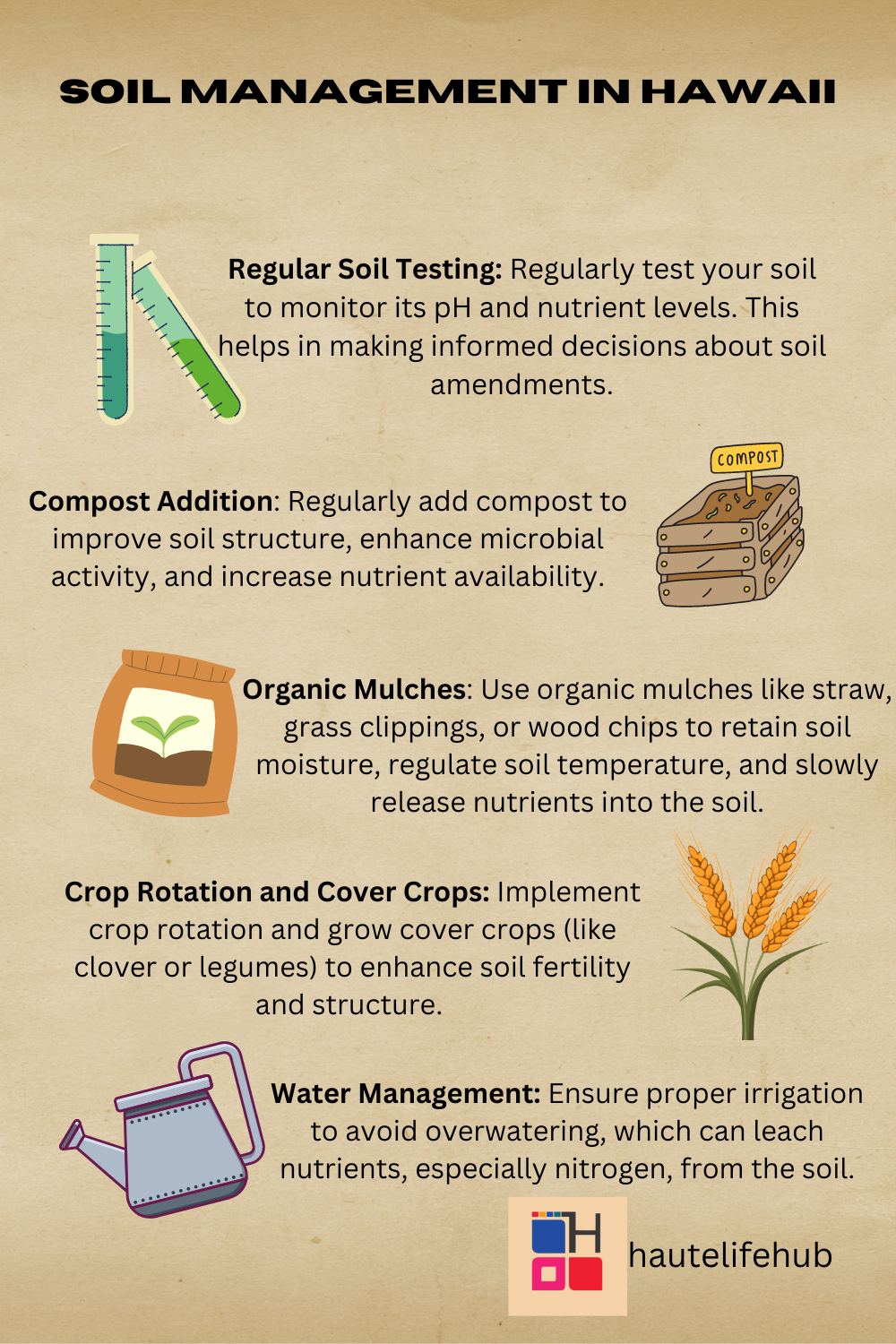
3. Plant Selection in Hawaii
Selecting the right plants for your garden in Hawaii involves considering the local environment, including climate, soil conditions, and native biodiversity. Here are detailed suggestions for plant selection, focusing on native, tropical, and seasonal options.
Native Plants of Hawaii
Benefits of Native Plants in Hawaii:
- Adaptation: Native plants are well-adapted to local soil, climate, and rainfall patterns.
- Wildlife Support: They provide habitat and food for native wildlife, promoting biodiversity.
- Low Maintenance: Typically require less water, fertilizers, and pesticides.
Native Hawaiian Plants:
- Naupaka (Scaevola spp.): Known for its unique half-flowers, Naupaka is a hardy shrub that can thrive in coastal areas and upland regions.
- ʻŌhiʻa Lehua (Metrosideros polymorpha): A versatile tree that grows in various habitats, from lava fields to rainforests. It produces striking red, yellow, or orange flowers.
- Koa (Acacia koa): A fast-growing tree valued for its beautiful wood and ecological importance. It provides habitat for many native birds.
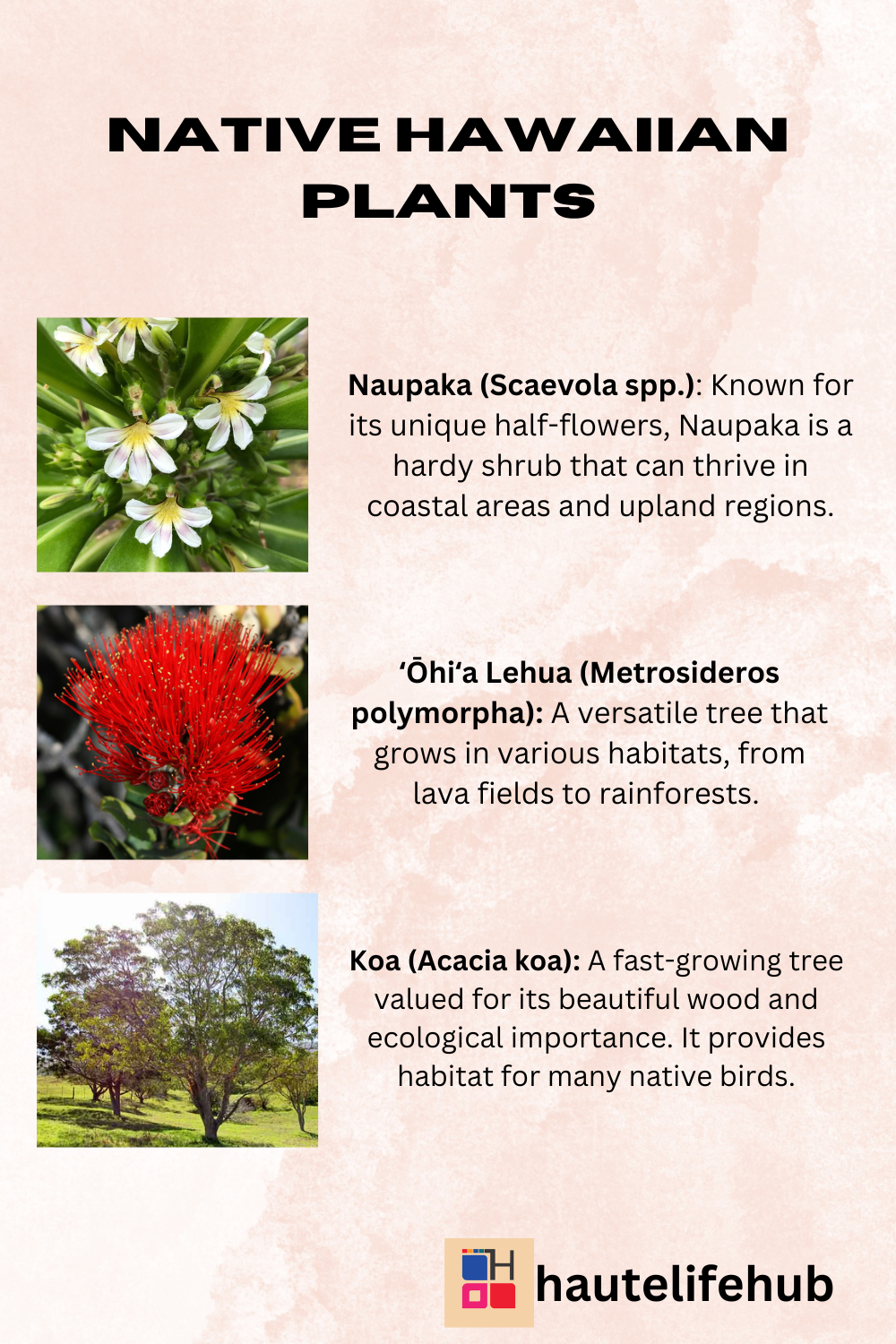
Tropical Plants of Hawaii
- Papaya (Carica papaya): A tropical fruit that grows well in warm climates with plenty of sunlight. It requires well-drained soil.
- Pineapple (Ananas comosus): Thrives in well-drained, slightly acidic soil and needs full sun.
- Taro (Colocasia esculenta): Grown for its edible corms and leaves, taro requires moist, fertile soil and is often cultivated in wetland areas.
- Plumeria (Plumeria spp.): Known for its fragrant flowers, this ornamental plant thrives in well-drained soil and full sunlight.
- Hibiscus (Hibiscus rosa-sinensis): A popular ornamental plant with large, colorful flowers. It prefers sunny locations and well-drained soil.

Seasonal Plants of Hawaii
Cooler Months (November to March):
Ideal for leafy greens and vegetables that prefer cooler temperatures.
- Leafy Greens: Lettuce, kale, spinach, and chard.
- Cruciferous Vegetables: Broccoli, cauliflower, and cabbage.
Warmer Months (April to October):
Suitable for tropical fruits and heat-loving plants.
- Tropical Fruits: Mangoes, bananas, and guavas.
- Summer Vegetables: Tomatoes, peppers, eggplants, and cucumbers.
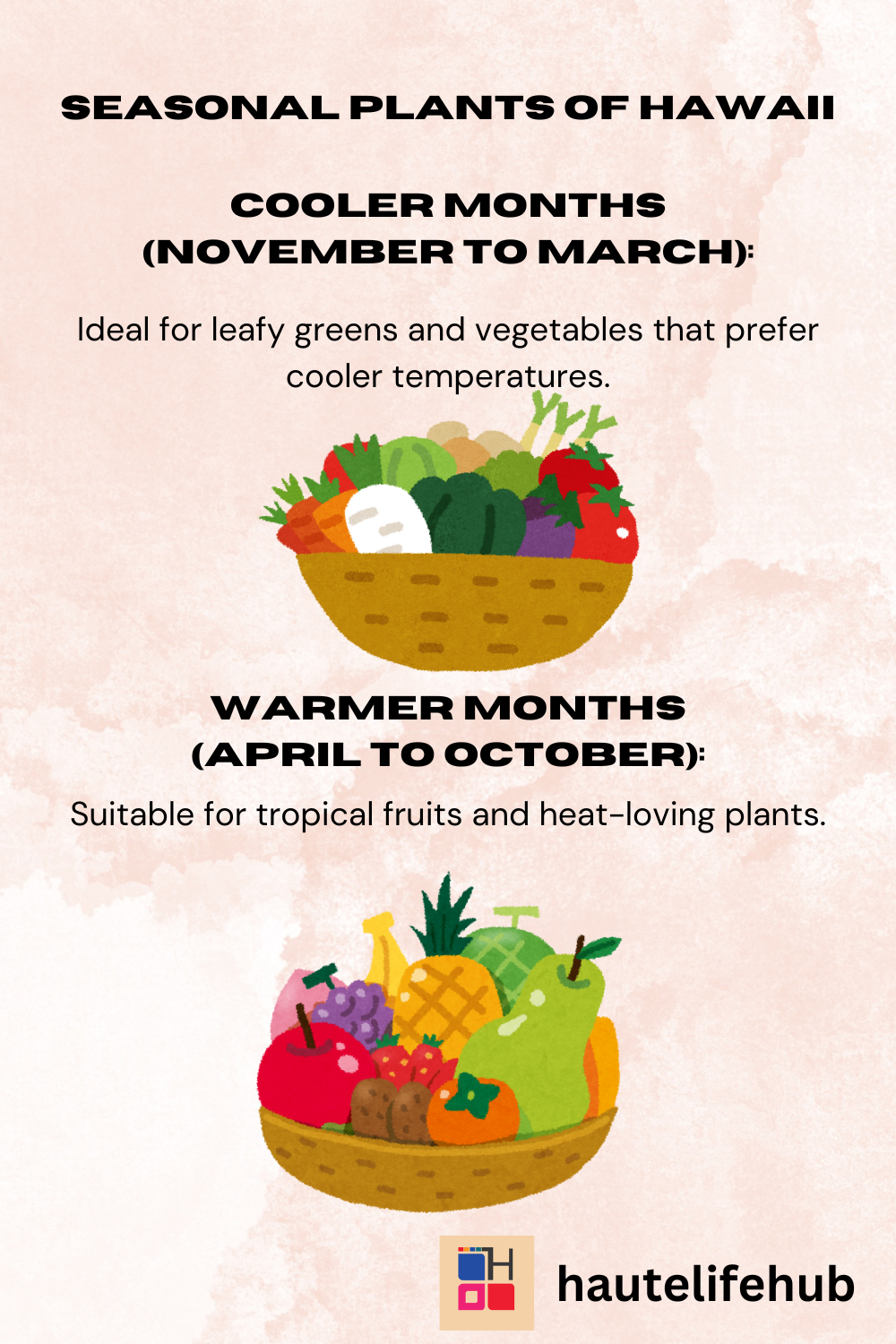
4. Watering in Hawaii
Efficient Irrigation Systems in Hawaii:
- Drip Irrigation: This system delivers water directly to the plant roots, minimizing evaporation and runoff. It’s especially useful in drier areas and helps conserve water.
- Soaker Hoses: These hoses release water slowly along their length, providing even moisture to garden beds.
- Watering Timing: Water plants early in the morning or late in the evening to reduce water loss due to evaporation. Avoid watering during the hottest part of the day.
- Rainwater Harvesting: Collect rainwater in barrels to use for irrigation, reducing reliance on municipal water sources and conserving water.

5. Mulching in Hawaii
Benefits and Techniques:
- Moisture Retention: Mulch helps retain soil moisture by reducing evaporation, which is crucial in dry and windy conditions.
- Weed Suppression: Mulch suppresses weeds by blocking sunlight, reducing competition for water and nutrients.
- Soil Health Improvement: Organic mulches, like straw, grass clippings, or wood chips, break down over time, adding organic matter and nutrients to the soil.
- Temperature Regulation: Mulch helps keep soil temperatures stable, protecting plant roots from extreme temperature fluctuations.
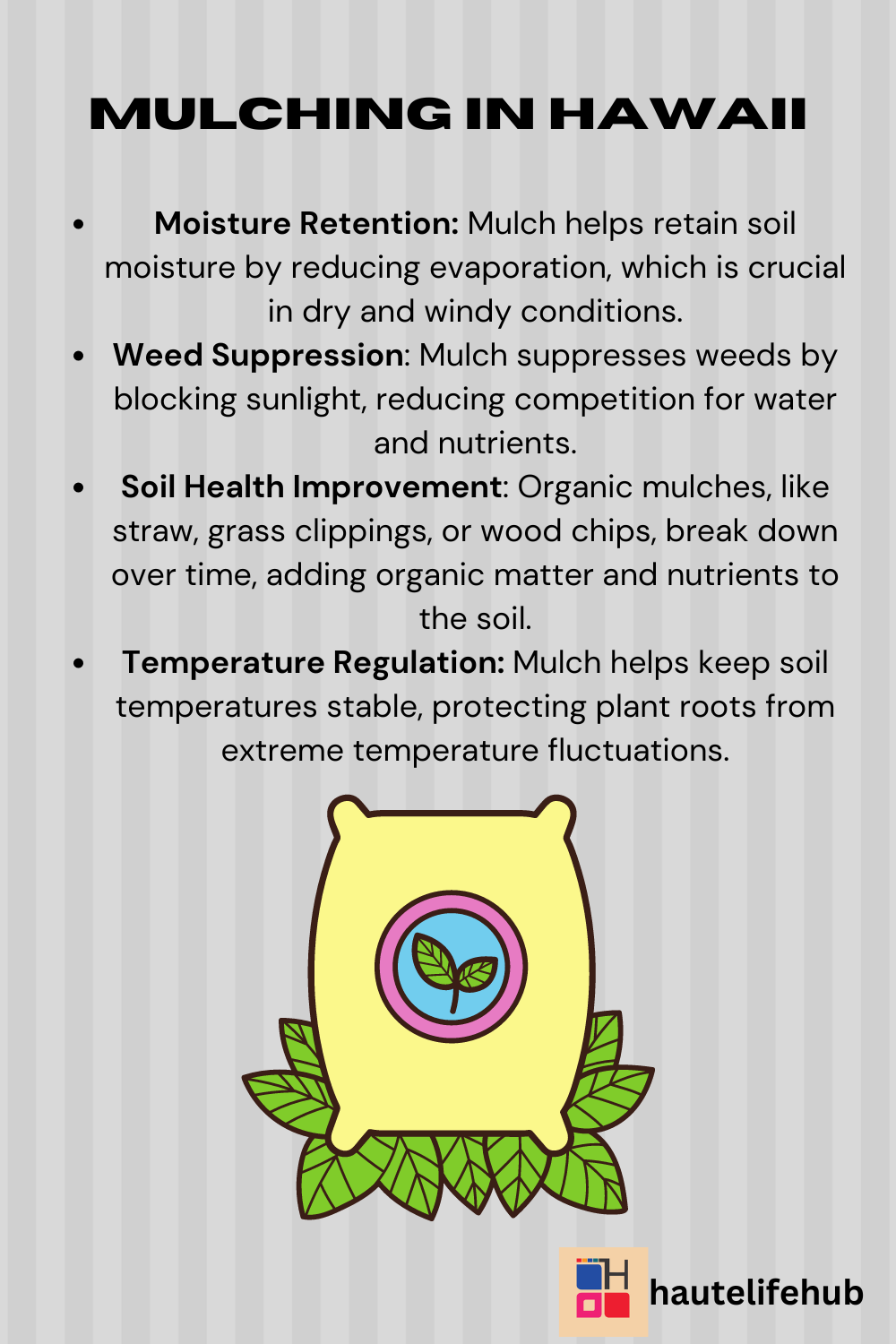
Application Tips:
- Depth: Apply a 2-4 inch layer of mulch around plants, keeping it away from the stems to prevent rot.
- Replenishing: Replenish mulch as needed, especially after heavy rains or windy conditions, to maintain its effectiveness.
6. Pest Control in Hawaii
Managing Common Pests:
- Slugs and Snails: Use barriers like copper tape or diatomaceous earth around plants. Hand-pick slugs and snails in the evening or early morning. Organic baits containing iron phosphate can also be effective.
- Invasive Insects: Identify and monitor pest populations regularly. Use neem oil, insecticidal soap, or horticultural oils to manage infestations.
- Beneficial Insects: Encourage natural predators like ladybugs, lacewings, and parasitic wasps by planting a variety of flowering plants and avoiding broad-spectrum insecticides.
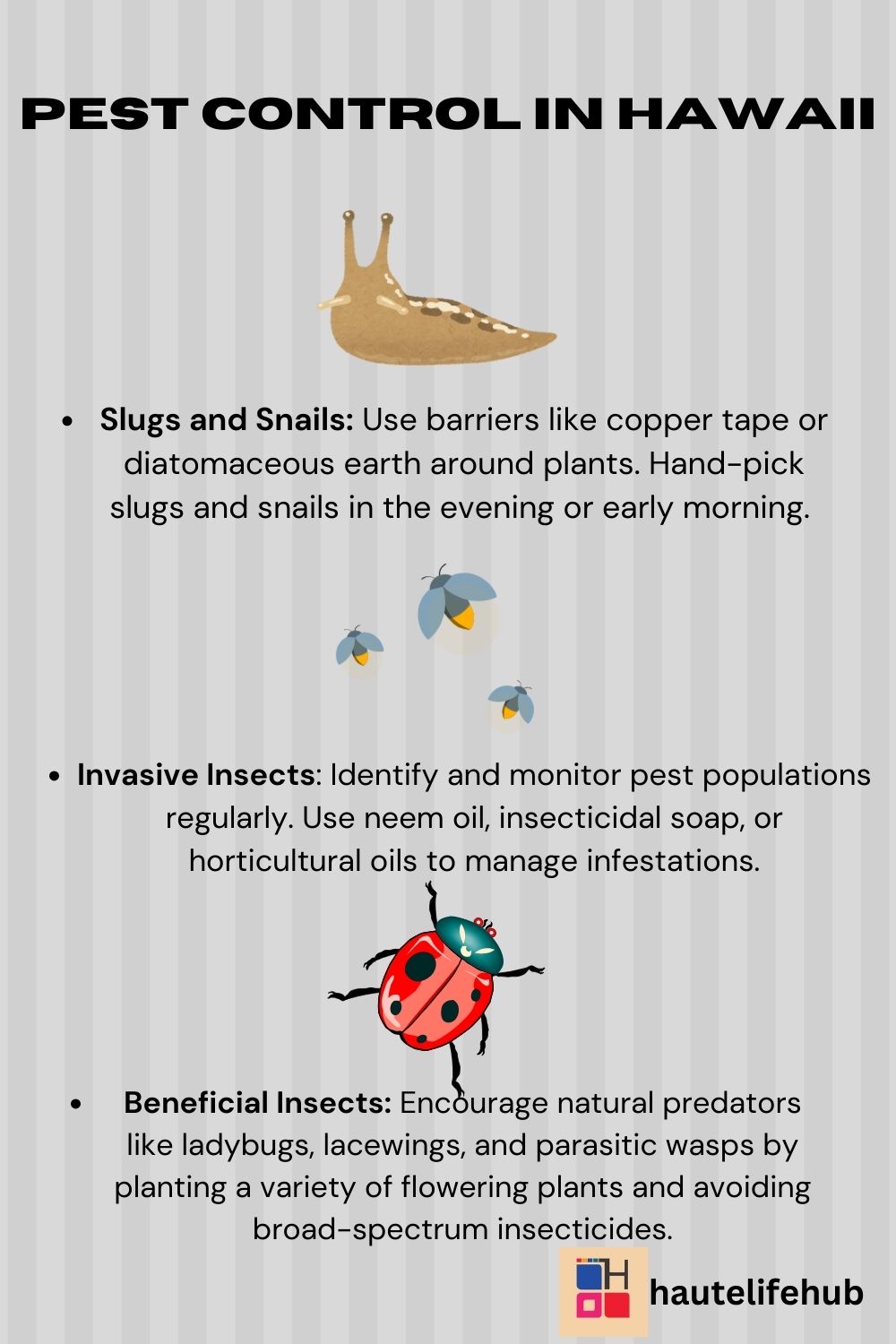
7. Disease Management in Hawaii
Preventing and Managing Fungal Diseases:
- Air Circulation: Ensure good spacing between plants to promote air circulation and reduce humidity around foliage. Prune plants to remove dense growth and improve airflow.
- Watering Practices: Water the base of plants rather than overhead to keep foliage dry. Wet leaves can create conditions favorable for fungal growth.
- Fungicides: Use organic fungicides like copper-based sprays, neem oil, or sulfur-based products if fungal diseases appear. Follow label instructions for safe and effective use.
- Sanitation: Remove and dispose of diseased plant material promptly to prevent the spread of pathogens. Clean gardening tools regularly to avoid cross-contamination.

8. Landscaping in Hawaii
In Hawaii, landscaping can be tailored to the specific conditions of different regions, from dry to wet areas. Here are detailed strategies for xeriscaping and rain gardens to enhance sustainability and beauty in your garden:
Xeriscaping
Xeriscaping is a landscaping method designed to reduce the need for irrigation by utilizing drought-tolerant plants and efficient water management practices. The term comes from the Greek word “xeros,” meaning dry, and it aims to create attractive, sustainable landscapes that minimize water use.
Benefits and Principles:
- Water Conservation: Xeriscaping reduces the need for irrigation by using drought-tolerant plants.
- Low Maintenance: These landscapes typically require less maintenance once established.
- Soil Health: Xeriscaping can improve soil health by reducing erosion and retaining moisture.
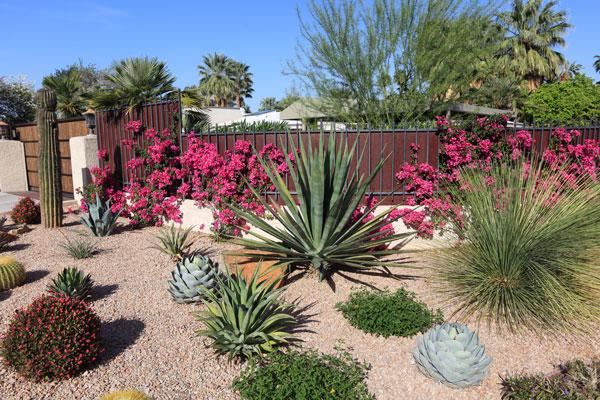
Design and Plant Selection:
- Drought-Tolerant Plants: Choose plants that are adapted to dry conditions and require minimal water.
- Native and Adapted Species: ‘Aki’aki grass (Sporobolus virginicus), Hawaiian bluegrass (Poa mannii), and various succulents like aloe (Aloe spp.) and agave (Agave spp.).
- Ornamental Plants: Bougainvillea, lantana, and rosemary are attractive, drought-resistant options.
- Zoning: Group plants with similar water needs together to optimize irrigation efficiency.
- Soil Preparation: Amend soil with organic matter to improve water retention and drainage.
- Mulching: Use mulch to reduce evaporation and maintain soil moisture.
Hardscaping Elements:
- Gravel and Rocks: Incorporate gravel, rocks, and pebbles to enhance aesthetics and reduce water usage.
- Paths and Patios: Create paths and patios using permeable materials to allow rainwater to infiltrate the soil.
Irrigation Techniques:
- Drip Irrigation: Install drip irrigation systems to deliver water directly to plant roots.
- Water Harvesting: Utilize rain barrels and other water-harvesting methods to collect and store rainwater for irrigation.
Rain Gardens
Rain gardens are shallow, landscaped depressions that collect and absorb rainwater runoff from impervious surfaces like roofs and driveways, reducing flooding, improving water quality, and supporting biodiversity.
Benefits and Principles:
- Runoff Management: Rain gardens help manage stormwater runoff, reducing erosion and improving water quality.
- Biodiversity: These gardens provide habitat for native wildlife and support a diverse range of plants.
- Aesthetic Appeal: Rain gardens can be beautiful landscape features that enhance property value.
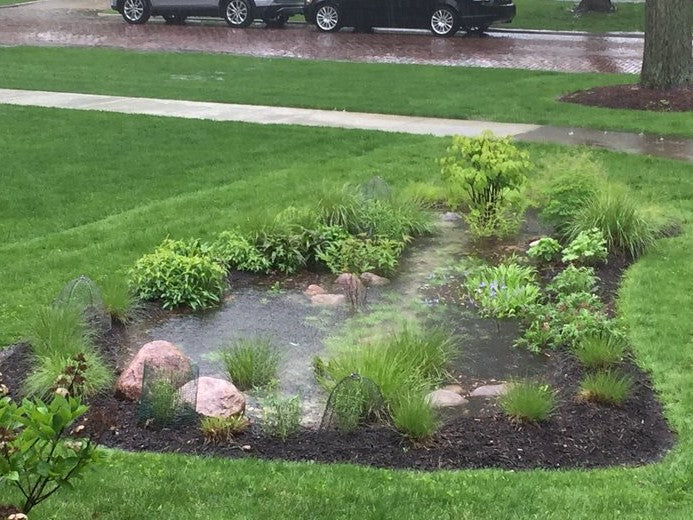
Installation Steps:
- Site Assessment: Evaluate the drainage patterns and soil type of your garden to determine the best location for a rain garden.
- Excavation: Dig a shallow depression, usually 6-12 inches deep, to create the rain garden.
- Soil Amendment: Mix compost into the excavated soil to enhance water absorption and fertility.
- Planting: Arrange plants according to their water tolerance, with water-loving plants in the center and drought-tolerant ones around the edges.
- Mulching: Apply mulch to help retain moisture, suppress weeds, and protect plant roots.
9. Community Resources of Hawaii
Leveraging community resources can greatly enhance your gardening efforts in Hawaii. Here are some key resources to consider, including local nurseries, extension services, and community gardens:
Local Nurseries of Hawaii
Benefits of Visiting Local Nurseries:
- Region-Specific Advice: Local nurseries have extensive knowledge about the plants that thrive in your area’s specific climate and soil conditions.
- Plant Varieties: They offer a variety of plants suited to local conditions, including native species and well-adapted exotic plants.
- Gardening Supplies: Nurseries provide essential gardening supplies such as soil amendments, fertilizers, tools, and pest control products.
- Workshops and Events: Many nurseries host workshops and events that can provide practical gardening tips and techniques.
Extension Services in Hawaii
University of Hawaii’s Cooperative Extension Service:
- Educational Resources: Provides a wealth of information on various gardening topics, including soil health, pest management, and sustainable practices.
- Workshops and Training: Offers workshops, webinars, and training sessions on gardening, landscaping, and agricultural practices.
- Soil Testing: Provides soil testing services to help you understand your soil’s pH and nutrient levels, allowing for more precise soil amendments.
- Publications and Guides: Access to publications, guides, and fact sheets that cover a broad range of gardening and agricultural topics.
- Master Gardener Program: Trains volunteers to become certified Master Gardeners, who then share their knowledge with the community through educational outreach.
Contact Information:
- Website: University of Hawaii Cooperative Extension Service
- Phone: Contact your local extension office for specific inquiries and services.
Community Gardens in Hawaii
Benefits of Participating in Community Gardens:
- Hands-On Experience: Provides practical gardening experience and opportunities to learn new techniques.
- Shared Knowledge: Collaborate with fellow gardeners and share knowledge, tips, and resources.
- Sense of Community: Builds a sense of community and fosters relationships with others who share an interest in gardening.
- Access to Land: Offers access to garden space, especially valuable for those who may not have sufficient space at home.
- Workshops and Events: Community gardens often host educational workshops and events on topics like composting, pest control, and organic gardening.
Utilizing Community Resources of Hawaii
- Visit Local Nurseries: Regularly visit local nurseries to stay updated on the best plant varieties and gardening practices for your area.
- Engage with Extension Services: Take advantage of the resources and support offered by the University of Hawaii’s Cooperative Extension Service to enhance your gardening knowledge and skills.
- Join a Community Garden: Participate in community gardens to gain hands-on experience, share knowledge, and build connections with fellow gardeners.
